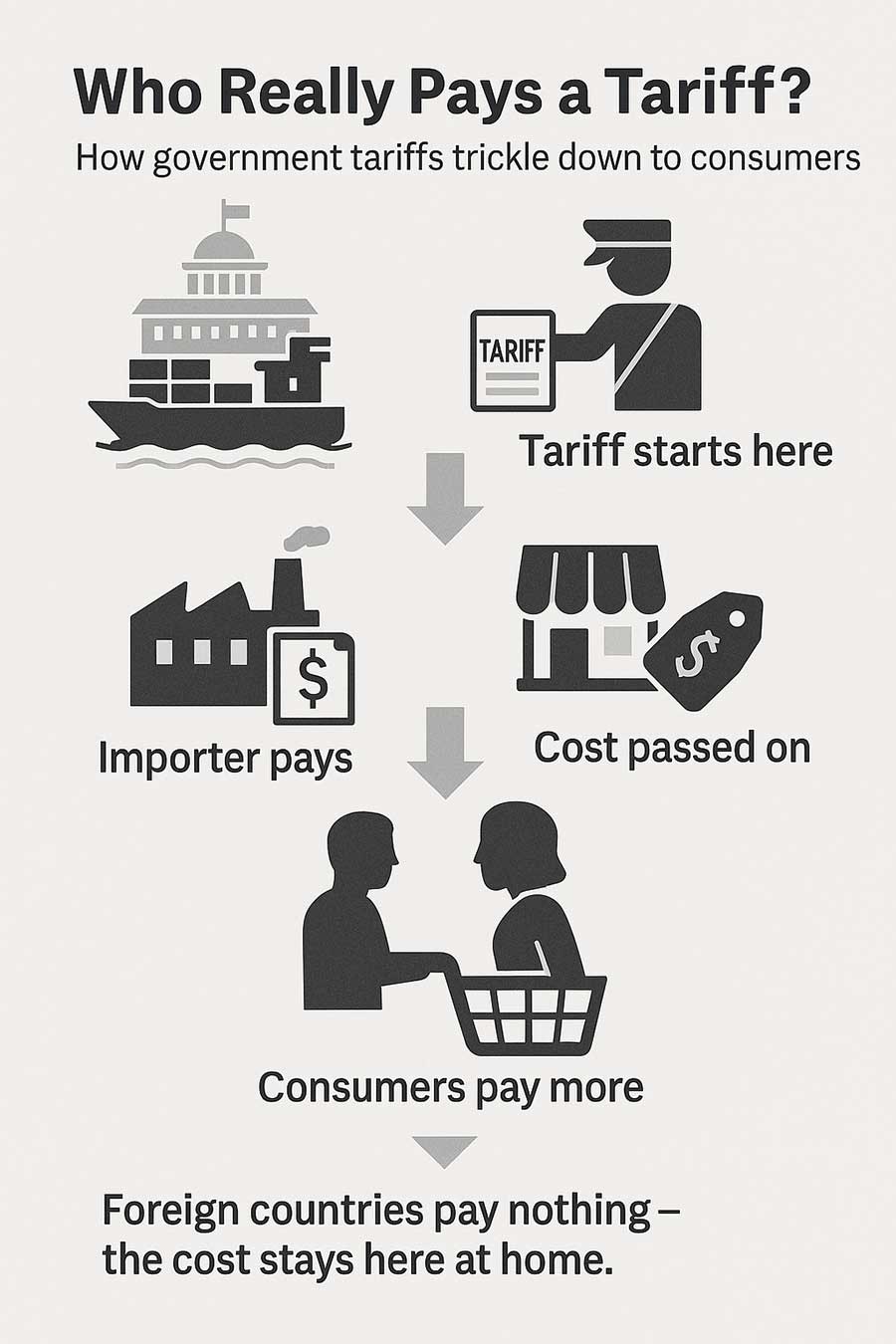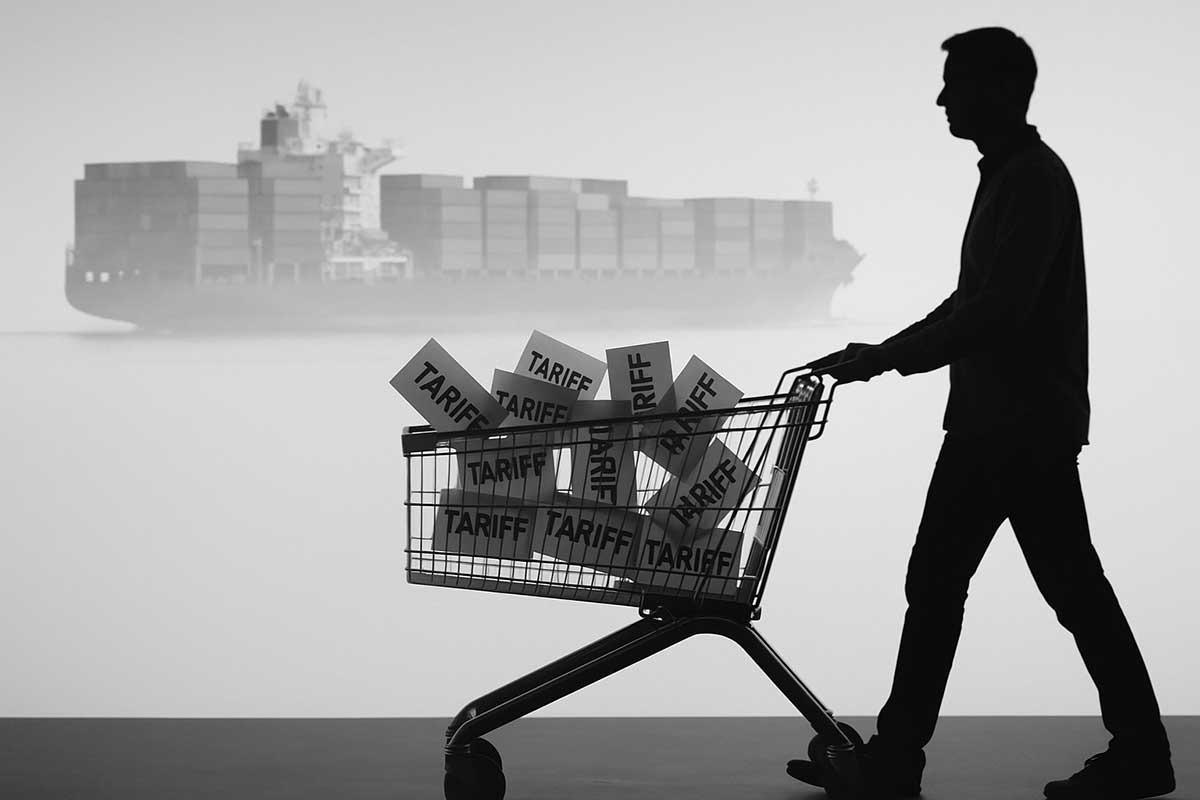Disclaimer: I am not a financial advisor, the info on this site is for educational purposes. All investing decisions should be based on your own research. Opinions expressed here are my personal views and should not be taken as financial advice.
Who pays a tariff? It is not the foreign country. A tariff is a tax on imports that the local importing business pays at the border, and that cost usually gets passed on to consumers like you and me through higher prices. Wealthy people don’t tend to feel the sting as much as people who live paycheck to paycheck.
Key takeaways
- Importers pay tariffs directly to Customs, not foreign governments.
- Businesses pass tariff costs down the chain, so consumers pay more at the register.
- Widespread tariffs push prices higher across everyday goods, which fuels inflation.
What a tariff really is
A tariff is a tax placed on goods that enter a country. Governments use tariffs to raise revenue or to pressure other countries during trade disputes. The important detail is who pays the tax at the moment the goods cross the border.
When a shipment arrives, the importing company files the paperwork and pays the tariff. The exporter does not cut a check to the U.S. Treasury. The cash leaves the importer’s account.
Who pays a tariff at the border
Importers do. Period. The importer of record pays the tariff to Customs before the goods clear. That payment is a direct, unavoidable business expense. It shows up in the importer’s landed cost of the product.
Here’s a quick example. Jim owns a small hardware store. He orders $50,000 worth of power tools from China to sell in his shop. When the shipment arrives in the U.S., Customs charges a 15% tariff. That means Jim must pay $7,500 in tariffs before he can pick up his goods. The Chinese manufacturer already received payment for the tools, their part is done. The U.S. government collects $7,500 directly from Jim, not from China.
Foreign countries are not paying this bill. That is the legal and operational reality every time goods enter the country.

How the cost hits consumers
Importers rarely absorb new taxes without raising prices. They pass higher costs to wholesalers and retailers. You experience the result at the store as a higher price on the shelf.
If you live paycheck to paycheck, even small increases add up. Groceries, clothing, tools, and electronics all feel a little pricier, which stretches the budget and cuts into savings.
Tariffs and inflation
When tariffs raise costs across many categories, the total effect is broader inflation. Each step of the supply chain adds a margin on top of a more expensive base. Enough categories get hit, and the average price level moves up.
This is why tariffs are not free. They are taxes that start with importers and end with households, especially when the items are everyday necessities.
Simple example: how a tariff flows through price
| Stage | Who pays | What changes | Example on a $20 item |
|---|---|---|---|
| Border | Importer | Tariff added to landed cost | 10% tariff = $2 tax. Landed cost becomes $22. |
| Wholesale | Retailer | Retailer buys at higher cost | Markup applied on $22, not $20. |
| Checkout | Consumer | Final shelf price is higher | Sticker might rise from $29.99 to $32.99 or more. |
Misinformation and tariffs
Let’s be clear. The claim that foreign countries pay our tariffs is not a different interpretation. It is a false statement. Certain media and political messaging repeat it because it sounds strong and simple. It shifts blame for rising prices and makes tariffs sound like a penalty on someone else.
Ask any economics professor in the country and you will get the same answer. Importers pay tariffs at the border. Those costs move through the supply chain and reach consumers. That is how a tax on imports works in practice and in the data.
The bottom line
Tariffs are paid by U.S. importers and then passed on to consumers, which pushes prices higher and adds to inflation. Other countries do not write the checks. Local businesses do, and households feel it whenever they shop. So tariffs are essentially a tax on American citizens.
💡 Explore our free financial tools:
- Salary increase calculator – see how a raise will impact your paycheck or annual income.
- Compound interest calculator – see how small investments grow over time.
- Debt payoff calculator – find out how long it takes to pay off your debt and what it’ll cost you.
- Subscription savings calculator – uncover the true cost of forgotten subscriptions.
- Student loan payoff calculator – plan student debt payments that fit your budget.
- Retirement investment calculator – check if your savings plan supports your retirement goals.
- Emergency fund calculator – learn how much cash to keep aside for peace of mind.
- Impulse buy calculator – double-check if those purchases are really worth it.
- Mortgage refinance calculator – see how refinancing could lower payments or save interest.
- Mortgage affordability calculator – find out how much house you can afford with your budget.
